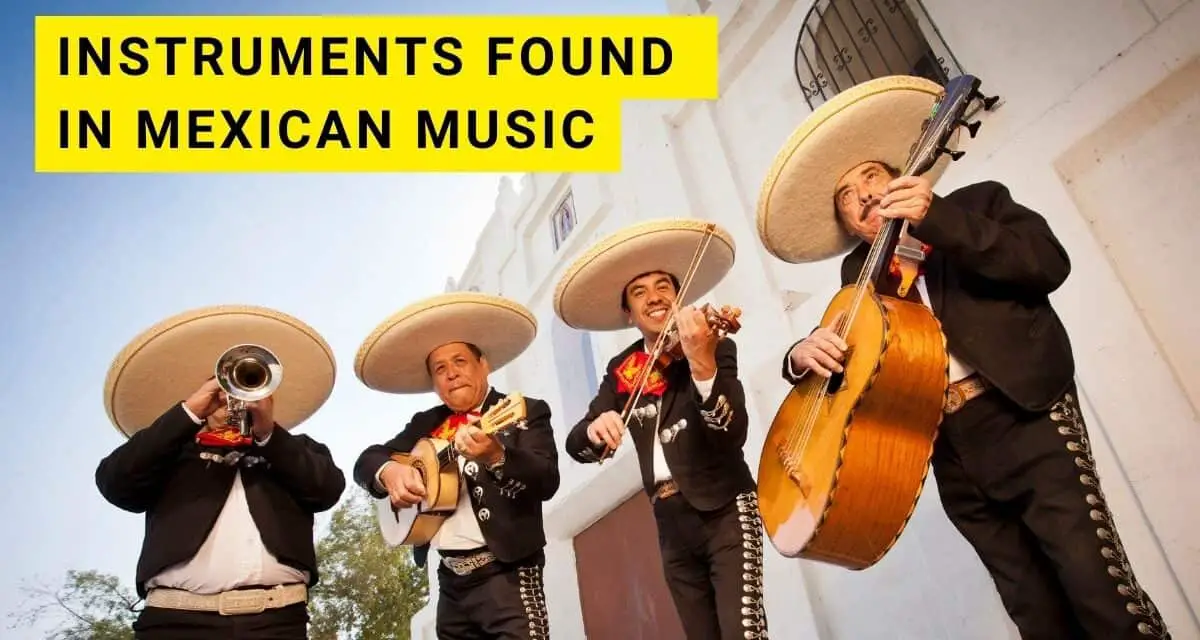Welcome to a symphony of culture and tradition, where each note echoes Mexico’s rich history.
This article lifts the curtain on the array of musical instruments that create the unique style of traditional Mexican music.
From strumming the classical guitar to the rattling of the Quijada musical instrument, each instrument plays a vital role in Mariachi and Banda music (and other popular Mexican music styles)!
Let’s embark on a journey through Latin America, as we discover the unique characteristics and the cultural significance of these musical companions. As we delve into the rhythm of the maracas or the melody line of the violin, we connect with the heart and soul of Mexico’s musical heritage. Let the music begin!
Vihuela
The Mexican vihuela is like the younger sibling to the guitar in a Mariachi band.
This Mexican instrument is smaller and higher-pitched. Its five strings strum out bright, rhythmic chords that make any tune bounce with that distinct Mariachi energy.
While it may not take the lead often, the Mexican vihuela is a key player that keeps the Mariachi band on beat and in sync and can be similar in sound to a tenor guitar.
Guitarrón
The guitarrón is one of the main Mexican musical instruments in Mariachi music. The sound produced by this hefty, six-stringed acoustic bass is the pulse of the band, supplying the rich, deep tones that underscore the rest of a Mariachi band.
It’s the guitarrón that keeps your feet tapping and your heart humming to the vibrant rhythm of Mexican tunes. It’s the unsung hero, giving depth and dimension to every song.
It is the bass instrument providing rhythmic bass lines for all other Mariachi instruments.
Requinto
The requinto guitar is the charming, high-pitched cousin of the guitar in traditional Mexican music. It’s smaller in size but big on delivering lovely, melodic lines that soar above the ensemble. You could say it’s like the lead guitarist in a rock band, often featured in solos that really showcase its vibrant sound. The requinto adds an extra layer of sparkle, making the music feel more intimate and personal.
Trumpet
The trumpet is the loud and proud brass voice in many traditional Mexican bands. Introduced to Mariachi in the 20th century, its clear, ringing notes command attention and add a special something to the mix.
When the trumpet starts to sing, it’s like a call to celebration. It has a flair for the dramatic, turning up the energy and providing those piercing high notes that make the music truly stand out.
Maracas
Maracas are the rhythm shakers of Mexican music. They’re simple percussion instruments, but don’t let that fool you. With just a flick of the wrist, they add a sizzling, syncopated spice to the music.
Maracas are the seasoning in the sonic stew, providing that extra rhythmic flair and making sure everyone is moving and grooving to the same beat. They’re like the fun, upbeat friend who gets everyone up and dancing.
Violin
In traditional Mexican music, the violin is like an eloquent storyteller. This string instrument weaves in and out of songs with its emotive strings, adding a touch of finesse and passion. A true chameleon, it’s at home playing sweet, lyrical melodies as well as fiery, virtuosic lines. In a Mariachi band, the violin is often the heart of the melody, carrying the tune with grace and style.
Mexican Harp
The harp in Mexican music is a true force to be reckoned with. With its array of strings, it can create a dazzling array of sounds from rhythmic strumming to beautifully intricate melodies.
It’s like the anchor of the traditional son jarocho ensemble, lending both rhythmic and harmonic support. The Mexican harp offers a unique texture that adds depth and a touch of old-world charm to the music.
Guitar
The guitar is the heart and soul of traditional Mexican music. With its six strings and warm, resonant sound, it provides the melodic and harmonic basis for many songs.
It’s perfect for serenading on a starlit night or setting the rhythm at a lively fiesta. Its versatility makes it a constant presence, whether in a soulful solo or as part of a larger ensemble.
Jarana Jarocha
The Jarana Jarocha is the life of the party in the music of Veracruz and is one of the most lively Mexican musical instruments.
This small, eight-stringed guitar-like instrument is known for its strident, rhythmic strumming. It’s like the heartbeat of a son jarocho ensemble, laying down a pulsing rhythm that drives the music forward. The Jarana Jarocha is all about community and celebration, keeping everyone on their toes and the party in full swing.
Accordion
The accordion is the breath of energy in traditional Norteño and Conjunto music. This button or keyboard-based instrument is beloved for its rich, full sound that can both carry a catchy melody and provide a rhythmic backdrop. It’s a kind of musical multitasker, lending an iconic, festive feel that’s essential to the styles it features in.
Marimba
The marimba in traditional Mexican music is a bit like a virtuoso pianist at a dance party. This keyboard-like percussion instrument is played by striking wooden bars and is known for its rich, resonant tones that range from deeply moving to exuberantly high-spirited.
With roots in African and indigenous Central American cultures, it’s especially prominent in the folk music of Chiapas and Oaxaca and has a prominent place within Mexican musical instruments.
Whether laying down a harmonic foundation or embarking on a rhythmic solo, the marimba infuses the music with a warm, vibrant energy that invites listeners to sway along.
Bajo Sexto
The Bajo Sexto, a twelve-string guitar-like instrument, is the solid foundation in Conjunto and Norteño music. Like the steady friend who’s always got your back, it provides a robust rhythmic and harmonic base that supports and complements the other instruments. Its deep, resonant sound contributes to the music’s distinctive, hearty character.
The Bajo Sexto evolved from the Bajo quinto and is a favored choice among Mexican musicians looking to provide a backup instrument.
Tamborita
The Tamborita, a small hand drum, brings an essential heartbeat to the traditional music of Sinaloa. Think of it as the rhythmic pulse, setting the tempo and offering a steady, driving beat that gets feet tapping. Its vibrant, percussive sound infuses the music with a liveliness that’s simply irresistible.
Huéhuetl
The Huéhuetl is an ancient drum that hails from the indigenous cultures of Mexico, like the Aztecs. This vertical, single-headed drum offers deep, resonant beats that echo the heartbeat of the earth. Its primal rhythms connect the music to its ancient roots, serving as a reminder of Mexico’s rich cultural history.
Teponaztli
The Teponaztli is another traditional instrument with a deep history. This slit drum, often made from a hollowed-out log, produces a variety of pitches when struck on the slits. It’s like the spoken word poet of the music world, adding a touch of unpredictability and charm to the rhythmic structure.
Zampoñas
Zampoñas, or panpipes, bring a unique and airy sound to the table. Composed of a series of cane pipes of varying lengths, they can create hauntingly beautiful melodies that feel like a fresh breeze. Whether it’s a soft accompaniment or a poignant solo, Zampoñas add a layer of ethereal mystery to the music.
Quijada
The Quijada, a percussion instrument made from an actual jawbone (often from a donkey), is a symbol of resourcefulness and creativity in traditional Mexican music.
When struck, it produces a unique, rattling sound that adds a raw and organic texture. It’s like the wild card in the deck, making each song it’s part of feel a little more earthy and connected to the natural world.
Flute
The flute in traditional Mexican music is a sweet and versatile voice that sings out clear, high melodies.
Whether it’s the delicate charm of a bamboo flute in indigenous music or the silver song of a Western concert flute in a Mariachi ensemble, the flute is like the bird on the musical landscape, its melodies flying over and weaving through the music, connecting all the elements together with its lyrical lines.
Trombone
Not just for jazz and classical, the trombone has found a special place in Mariachi bands too. With its slide feature, it can hit a wide range of notes, adding an extra layer of depth to the band’s sound.
It’s like the versatile actor of the musical stage, lending its voice to the rich harmonies and providing powerful counterpoints to the melodic lines.
Bandolón
Picture a mandolin, but supercharge it with extra strings and you’ve got the Bandolón.
This mighty instrument, strummed with a plectrum, enriches the Mariachi ensemble with its vibrant, rhythmic strumming.
It’s like the orchestra conductor, guiding the tempo and rhythm, while adding its own unique color to the overall sonic picture.
Jaranas
Jaranas are like the jolly crowd-pleasers of the party. These guitar-like instruments come in several types, each adding their own regional flavor to the music.
Known for their rhythmic strumming, they provide a driving beat that keeps the music flowing and the listeners’ feet tapping. Jaranas bring the spirit of community and celebration, turning every gathering into a musical fiesta.
Leona
The Leona is like the deep-voiced singer in the ensemble of son jarocho music.
A large, fretted, guitar-like instrument, it provides a resonant bass sound that underpins the group’s harmony.
Imagine the Leona as the strong and steady foundation of a house, grounding all the other instruments with its profound, rhythmic pulse.
Ayoyotes
Ayoyotes are a literal step into the rhythmic world of indigenous dances. These ankle rattles, made from dried shells of the ayoyote tree seeds, add a unique percussive sound to the music.
Picture dancers moving in rhythm, their feet creating a captivating, syncopated beat. Ayoyotes add a kinetic, visual element to the music that’s as mesmerizing to watch as it is to hear.
Ocarina
The Ocarina is the mysterious storyteller of ancient Mexican music. This vessel flute, often ceramic, produces an ethereal, haunting sound that resonates with Mexico’s rich history.
It’s like the wise elder in the musical tribe, singing songs of old with a voice that seems to whisper the secrets of the past. The ocarina’s music connects the present to the ancient cultures of Mexico in a profound and beautiful way.
The Wonderful Collection of Mexican Musical Instruments
And there you have it – a vibrant ensemble of traditional Mexican instruments, each with its own unique voice and story to tell.
Through their strings, skins, and reeds, we’ve journeyed through time and culture, felt the heartbeat of fiestas, and discovered the soulful melodies that narrate the rich tapestry of Mexican life.
While each instrument contributes its distinct sound, it’s their harmonious collaboration that creates the vibrant symphony we recognize as traditional Mexican music.
As this journey comes to an end, the echo of these instruments serves as a reminder of the beautiful diversity and deep-rooted heritage inherent in Mexico’s melodious landscape. So here’s to the music, the magic, and the memories they inspire – Viva la Música Mexicana!






